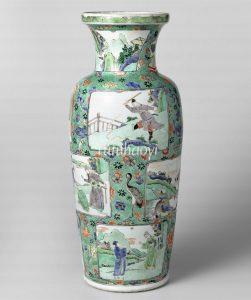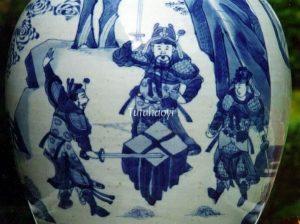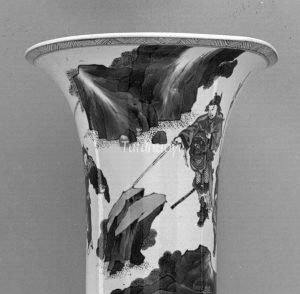Liu Bei and Sun Quan chopping stone
刘备孙权砍石问天(孙刘试剑)
© Tutuhaoyi.com owns the copyright of the description content for the images attached. Quoting all or part of the description content on this page is permitted ONLY IF ‘Tutuhaoyi.com’ is clearly acknowledged anywhere your quote is produced unless stated otherwise. (本页描述内容版权归Tutuhaoyi.com所有,转发或引用需注明 “Tutuhaoyi.com”, 侵权必究, 已注开源信息的条目除外。)
In the 14th-century historical novel, Romance of the Three Kingdoms (三国演义 – 甘露寺招亲), the generals in the Dongwu (东吴) kingdom conspired to murder Liu Bei (刘备), head of the Shu Han (蜀汉) kingdom, by inviting him to their territory with the promise of their king Sun Quan (孙权)’s sister for his wife. When Liu Bei was trapped in Sun Quan’s camp, he seized an opportunity while he was standing beside a large rock in the garden. Taking an attendant’s sword, Liu Bei pledged to Heaven, ‘If I am destined to succeed in my mission of reviving the Han, let this sword cut through the stone. Otherwise, let the stone remain intact.’ As he struck, the stone split in two. When Sun Quan came onto the scene and asked Liu Bei what he had wished for, Liu told him a lie to throw him off the scent.
Sun then gripped his own sword and cried, ‘I, too, shall put a question to Heaven.’ To himself, Sun Quan swore, ‘If Dongwu is to thrive, let the rock split!’ The giant stone broke again with Sun’s strike!
This tale aptly illustrates the expression, ‘being strange bedfellows’, i.e., sharing the same bed, but having different thoughts and dreams. The cross cracks on the rock are evidence of two strange bedfellows’ inner thoughts.
The story scene on the porcelain ware illustrated here was first deciphered by Yibin Ni. More of his interesting discussion on this topic is available here.
Fig 1-2: rolwagen vase, Kangxi period (c.1700), courtesy of Rijksmuseum, Holland
Fig 3: blue-and-white porcelain jar, Kangxi period (1662-1722), Qing dynasty, courtesy of Mr Chen Minliang’s private collection, Singapore
Fig 4-5: porcelain vase, Kangxi period (1662-1722), Qing dynasty, courtesy of the Metropolitan Museum of Art, New York




